José Emilio Pacheco (Mexico City, 1939–2014) was a bibliophile and polymath who devoted his life to literature in different facets as poet, novelist, storyteller, essayist, translator, anthologist, journalist and cultural chronicler.
Among his key works are Battles in the Desert (1981), his most read book, considered a part of the literary baggage of several generations; and the anthology Sooner or Later (2009), which brings together his poetic work. On the other hand, his career was always associated with magazines and supplements such as Revista de la Universidad, México en la Cultura a supplement of newspaper Novedades, and La Cultura en México a supplement of Siempre!. Over the course of four decades he wrote the weekly “Inventario” —first in Excélsior and then in magazine Proceso—, his culture column was considered one of the most important and well read, in the country.
He received many honors and distinctions, most notably his appointment as Honorary Academic of the Mexican Academy of Language (2006); the Reina Sofía Ibero-American Poetry Award (2009), awarded by the National Heritage of Spain and the University of Salamanca, and the Miguel de Cervantes Prize (2009).
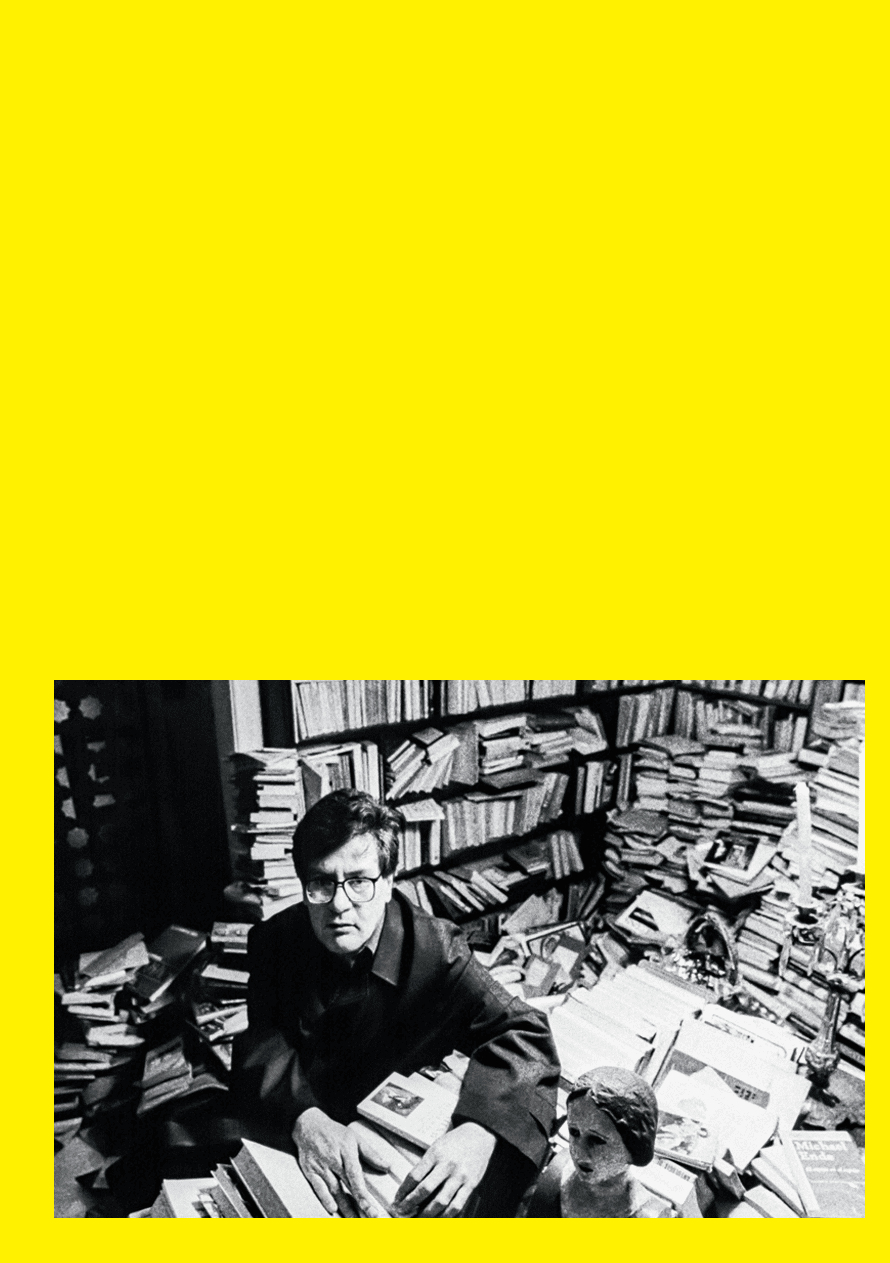
Padel is a sport invented by businessman Enrique Corcuera, which is played in pairs with a wooden racket and a ball in a walled-in court.
It was 1969 and Don Enrique decided to adapt a plot of his house in Las Brisas, Acapulco, to play. The land was approximately 20 meters long and 10 meters wide —not big enough for a tennis court— to which he built surrounding walls to prevent vegetation from invading it.
In the middle of that court of unusual features, he placed a tennis net and began to try out a game that he then practiced with a racket and a paddle tennis ball. The sport evolved to have its own rules and elements, and gained popularity among tourists visiting the port. Prince Alfonso of Hohenlohe took it to Costa del Sol in Spain in 1974.
The Padel Pro Tour (PPT) is the most important professional circuit of this sport worldwide. Argentina, Brazil, Canada, Uruguay, Chile, United Kingdom, Spain and Portugal are countries where padel has had a great development. In 1991, the Mexican Padel Federation was founded to promote this sport in the country.

Upon his arrival in the New World, Cortés was adorned with garland necklaces woven with curious edible and delicious flowers that the natives called mumúchitl. Later he learned that in reality those small buds were not born so, but were grains of maize burst with heat, which were eaten at festivities in honor of Xipe Totec, god of regeneration, maize and war.
Sahagún described mumúchitl as “a very white flower in each grain”. The indigenous people obtained it by placing the cobs on the fire, skewed on a stick, or separating the grains and heating them in clay pots with sand.

Founder of the Colegio de Arquitectos de México in 1946, Mario Pani (Mexico City, 1911–1993) was the architect who most contributed to the design and construction of the current configuration of Mexico City, whose legacy transcends by going beyond architecture projecting in the context of social life.
In the midst of the so-called “Mexican miracle”, the vertiginous population growth in the country caught Pani’s attention, who began to take an interest in popular housing. According to his approach, the unavoidable urban densification had to take into account a balance between the needs of modernity and improvement in the quality of life of inhabitants.
His vision on functionality ranged from residences and condominiums to hospitals, schools, hotels and urbanization plans. Among his projects that promoted this concept are the large-scale ones such as UNAM’s Ciudad Universitaria (1952) —in co-authorship with Enrique del Moral— and Ciudad Satélite (1954), and later buildings such as the Torre Insignia (1962) and the Conjunto Urbano Nonoalco Tlatelolco apartment complex (1963).
He is also known for his work of dissemination, through magazine Arquitectura (1948). He was a member of the international jury of the São Paulo Biennial in 1951 and received, among others, the National Prize for Arts and Sciences in 1986.

Mexico is a country of celebration and color. The calendar has countless dates in which each state enhances its traditions through dance, handicrafts, gastronomy and ceremonies in honor of some saint, a sacred food or simply for the joy of life or death.
From Baja California to Quintana Roo one could take a tour of the folklore of Mexican festivities. In 2010 one of these celebrations was inscribed in the Representative List of Intangible Cultural Heritage of Humanity: the Parachicos.
Known as the Fiesta grande of Chiapa de Corzo, in Chiapas, this celebration is held during January and is dedicated to Our Lord of Esquipulas, Saint Anthony Abbot and Saint Sebastian. One of its most representative manifestations are the dances of the Parachicos, considered a communal offering to the venerated saints.
The dancers wearing serapes, embroidered shawls, multicolored ribbons and a fiber headdress, hide behind carved cedar wood masks —whose features resemble those of the Spaniards of the time of the Colony— and go along the streets carrying holy images, while playing tin maracas called chinchines. They are led by a character that carries a guitar and flute and, accompanied by drummers, sings prayers that are answered by the Parachicos.
The chants, costumes and the mask-making technique survive having been passed from generation to generation, for over 300 years.
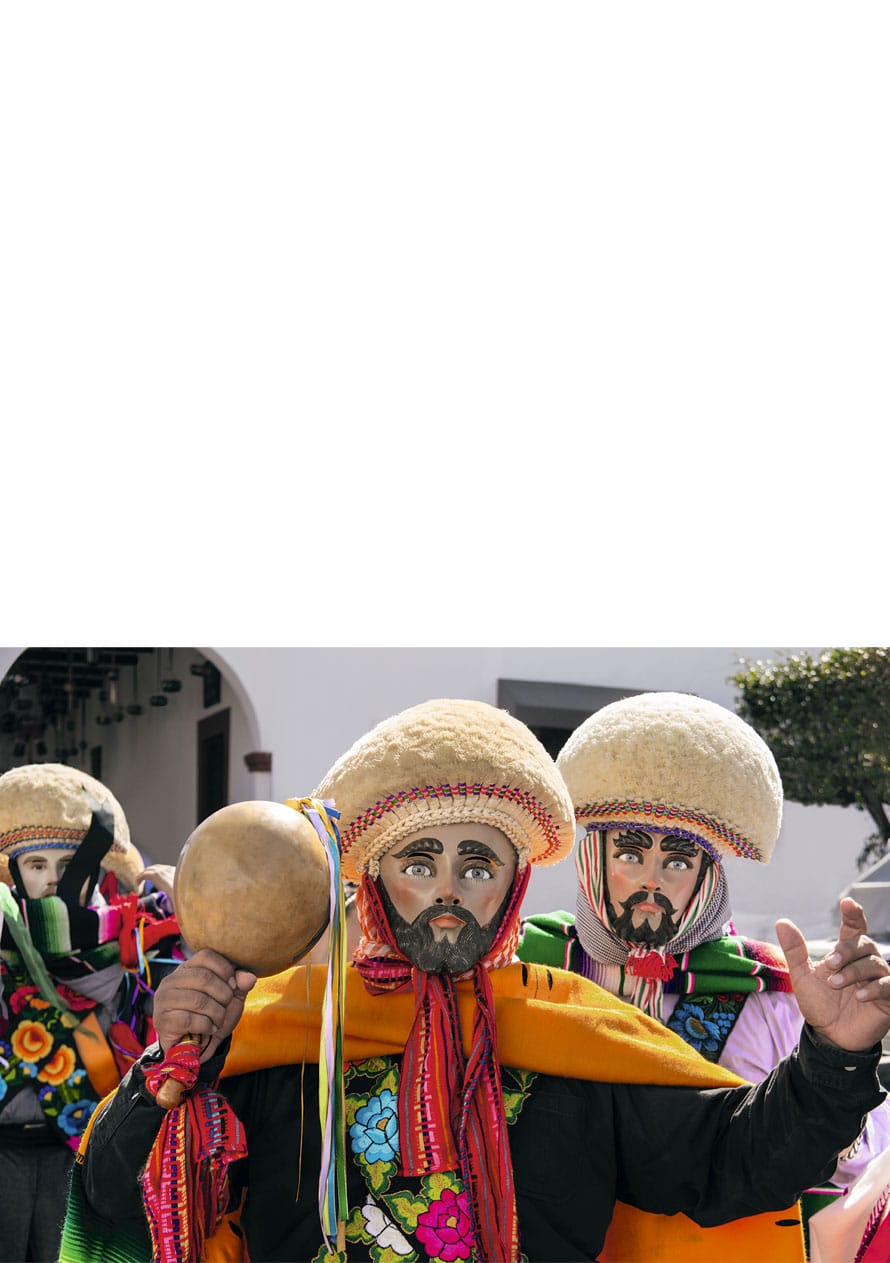
As conductor, Alondra de la Parra (1980) has been at the head of over 75 orchestras around the world, including the most prestigious in United States, France, Germany, Japan, Brazil, Sweden and Russia, as well as the London Philharmonic Orchestra, the Cameristi della Scala at Milan, and the Orquesta Nacional of Spain. She was the first Mexican woman to be invited to conduct in New York and has been named Official Cultural Ambassador of Mexico.
In 2004 she founded the Philharmonic Orchestra of the Americas in New York, to promote both Mexican and Latin American classical music. With this orchestra she recorded My Mexican Soul, her first album, and undertook an educational project with children from public schools in the Bronx and Harlem.
In Mexico, she launched the Armonía Social program, which has helped many children find a haven in music by working with children and youth orchestras such as that of Ciudad Nezahualcóyotl; Tlahuitepec, in Oaxaca; Ciudad Renacimiento, in Guerrero; and the Children and Youth Orchestra of Mexico.

Fernando del Paso (Mexico City, 1935–Guadalajara, Jalisco, 2018) was a peculiar man who knew how to travel and move brilliantly among several worlds. He masterfully practiced narrative, but also poetry, painting, journalism, advertising and even gastronomy.
A lover of literature, colors and humor, since childhood he took advantage of his ambidextrous ability —“ambisinister”, as he called it— to explore his two great passions: drawing and writing. He could literally write with his left hand and simultaneously draw with the right one.
He also moved from the field of intellectual literature to the world of best sellers. While Palinuro de México (1977), his made-up autobiography, earned the reputation of a work reserved for cult readers, News from the Empire (1987) burst in as an immediate sales success that reached all kinds of audiences, and years later was chosen in a survey among a plethora of writers as the most important Mexican novel in three decades.
Both novels he wrote completely by hand, in his long stay between London and Paris —thanks to the support of the Guggenheim Fellowship. At that time, he also served as a radio program producer, writer and broadcaster at the BBC and Radio France. In 2015 he was awarded the Cervantes Prize in recognition of “his contribution to the development of the novel, combining tradition and modernity as Cervantes did in his time”.

In December 1990, the poet, narrator, essayist, translator, editor and great promoter of Mexican literature, Octavio Paz (Mexico City 1914–1998) received the Nobel Prize for Literature that the Swedish Academy awarded him in recognition for his “impassioned writing with wide horizons, characterized by sensuous intelligence and humanistic integrity”.
The body of his work is full of essential essays for contemporary culture. In The Labyrinth of Solitude (1950) he dissected the psychological construction of Mexican people; in The Bow and the Lyre (1956) he tried to decipher the poetic phenomenon; and in The Double Flame (1993) he explored the feeling of love and eroticism, in addition to many other texts dealing with art, society, history and international politics. But, for Paz, everything flowed back into poetry and that is where the axis of his literature and his raison d’être lie. Libertad bajo palabra (1960) brings together his poems written between 1935 and 1957 and covers topics such as loneliness, love, death, solidarity and social contradictions.
The poet who said that “the Nobel Prize is not a passport to immortality”, was distinguished with many awards, but above all recognitions, his legacy is incalculable and permanent. His work made him one of the most lucid Mexicans of the second half of the 20th century, a reference of universal thought, literature and poetry.
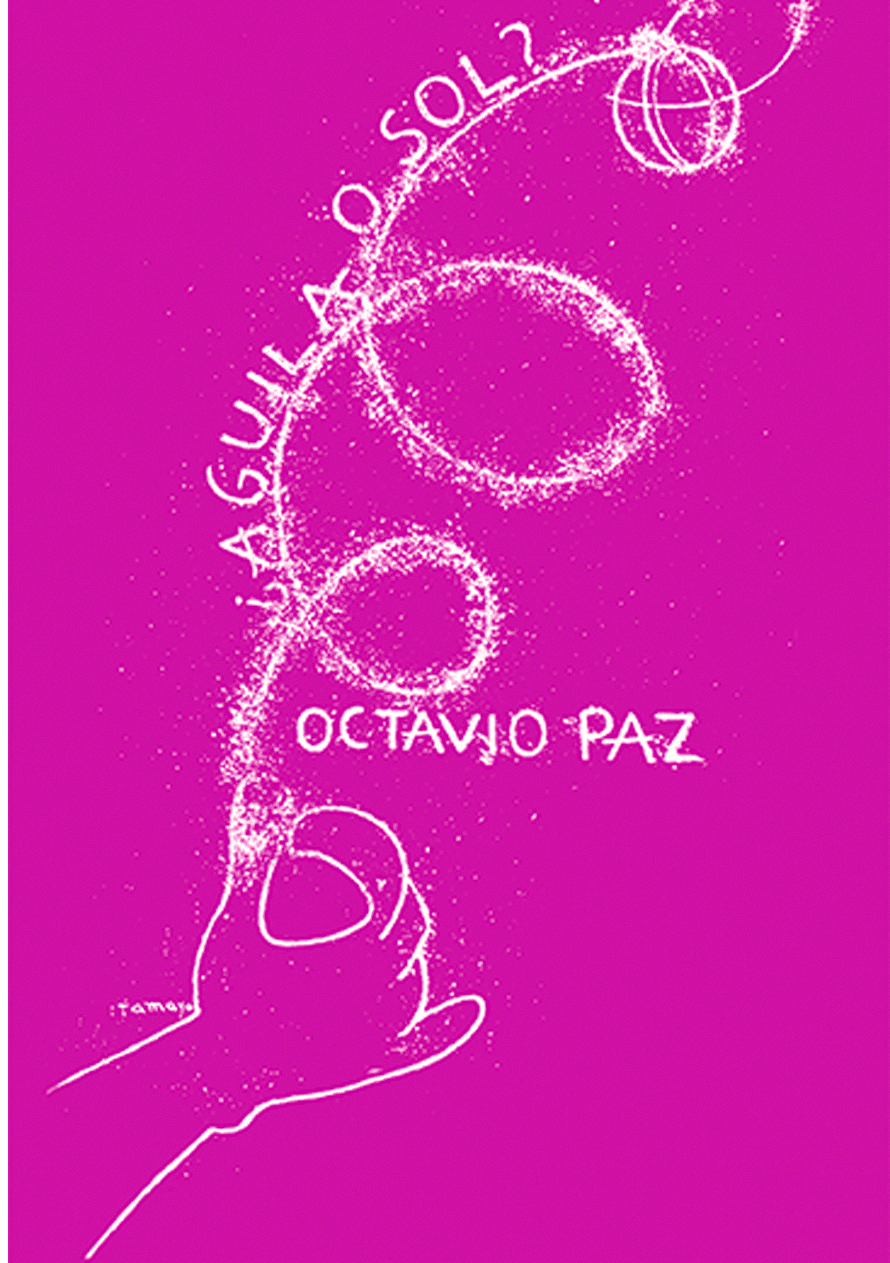
Pearl trade in Mexico dates from the pre-Columbian era. Maya and Aztec merchants roamed the limits of their empires in search of these gems with which they made jewels to honor royalty and the gods.
In 1535, Hernán Cortés embarked in search of the treasures of the New World and found a source of wealth, known since then as the “Sea of Cortez”. In these waters the “black pearl” was formed and soon became the star product of Mexican export known as the “Queen among gems, the gem of queens”, since its use became fashionable among European nobility. This reign lasted until the end of the 19th century, when pearls almost became extinct due to overfishing. They survived thanks to Gastón Vives, creator of the first oyster farm in the world that worked successfully from 1902 to 1914.
It took several decades for the revival of pearler activity in the Gulf of California, which happened in 1993 spearheaded by Enrique Arizmendi, Manuel Nava and Douglas McLaurin Moreno, creators of an aquaculture project in which the species Pteria sterna was cultivated, and thanks to which Mexican pearl farming has resumed its position as one of the most exclusive productions in the world.
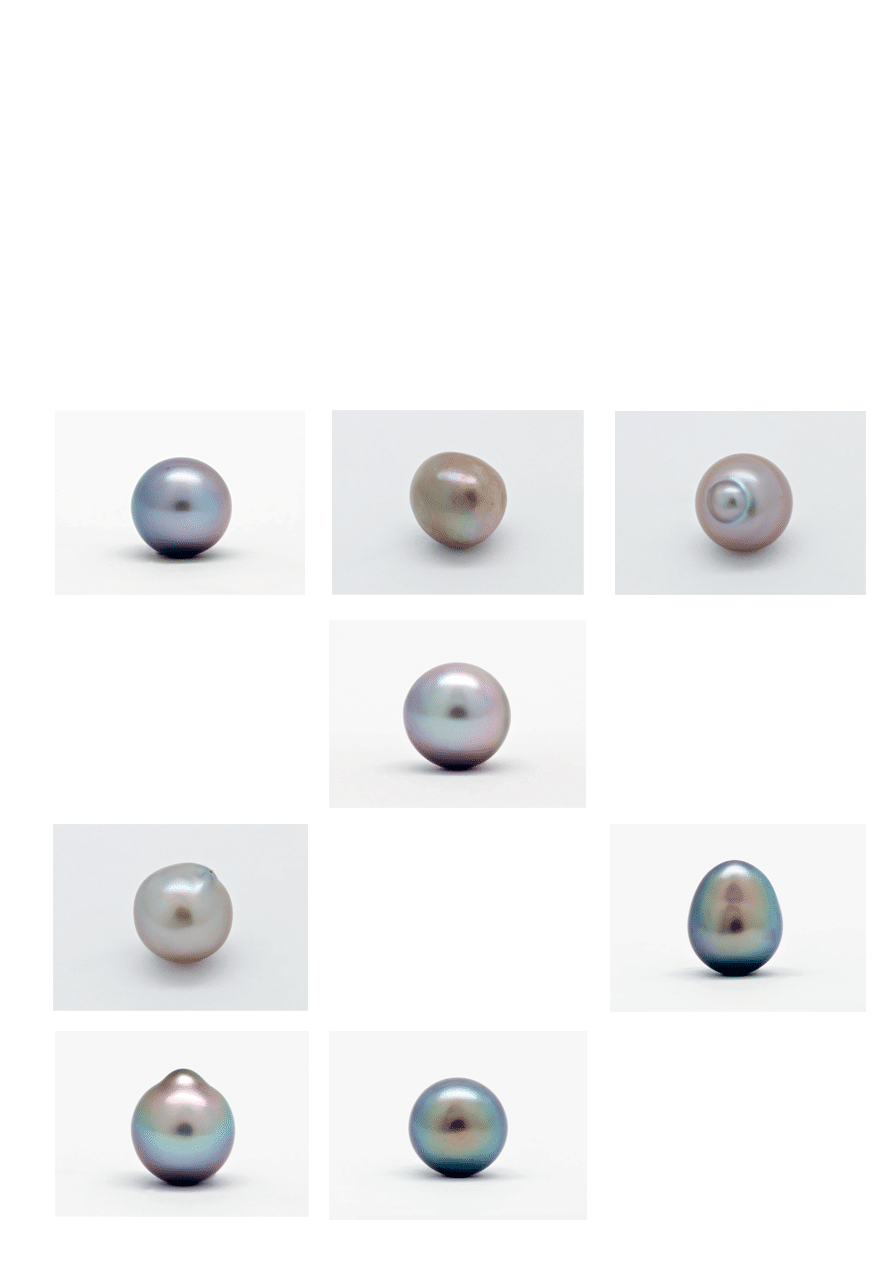
Chihuahua dogs are considered the smallest breed in the world, with a height ranging from 15 to 25 centimeters. Playful, nervous and very popular, they are descendants of the tlachichi, a companion dog bred by the Toltecs, with a sharp snout, long coat and upright ears, which had the special feature of being mute.
In the Florentine Codex, Friar Bernardino de Sahagún described three types of pre-Hispanic dogs: the izcuintli, which simply means “dog” in Nahuatl; the xoloitzcuintli, “weird dog”; and the tlalchichi or chichi, “floor dog”. This last race tended to decrease in size and its evolutionary process continued until it became the Chihuahua.

This small cactus, native to the desert of Northern Mexico, is a ritual plant that has been considered sacred for more than six thousand years by indigenous communities such as the Cora, the Rarámuris and the Wixáritari —Huichol—, who consume it to resist lengthy work hours and long walks.
Every year, the marakames guide the Huichol on a sacred pilgrimage to the Wirikuta Desert in San Luis Potosí, to search for hikuri, the peyote god.
In traditional indigenous medicine it has been used as a remedy for diseases such as diabetes, pneumonia and cancer. It is attributed with analgesic properties capable of fighting toothaches, arthritis or asthma, among other ailments. It is also useful for inducing labor, increasing sexual desire and as a treatment against snakebites, scorpion stings and other types of poisoning.

Pico de gallo is a hybrid between sauce and salad traditionally prepared with tomato, onion, jalapeño chili pepper and coriander, all fresh and diced; some preparation methods include a few drops of lime juice.
This seasoning is a classic of Mexican cuisine that is used to accompany any dish, but especially molletes, nachos, quesadillas and tacos, or simply to enjoy with tortilla chips. Due to its uses and ingredients, and for bearing the traditional colors of the national flag, it is considered the queen of sauces. It is also known as raw sauce, chopped sauce, Mexican sauce or flag sauce.
There is no confirmed theory about the origin of its name. The Diccionario enciclopédico de la gastronomía mexicana states that it is named this way because its ingredients are finely chopped and resemble the food that birds feed on, although many people are inclined to believe that it is called this way because you have to be tough to eat it, since in Spanish gallo can mean both rooster and tough.

Invented by engineer Manuel González Flores (Tecajete, Hidalgo, 1908-1986), control piles are used to lay or reinforce building foundations in unstable and deformable ground. Their use was implemented in 1948 and represented a solution to the serious differential movements that occur in heavy buildings in Mexico City.
This is an innovative system because piles supporting the entire building structure pass through it —unlike others where they are attached to the foundation— and are linked to it by a loading mechanism that contains compressible material between the frame and tip of the pile; thus, when the weight of the building deforms the material, it is possible to carry out maintenance and the structure will continue to be stable.
González Flores received the patent in 1951 and since then foundations of hundreds of buildings have been laid or strengthened, achieving an important architectural rescue. In 1966 he was awarded the National Engineering Prize, presented by president Gustavo Díaz Ordaz.
Other notable contributions of Manuel González Flores to the world of engineering were the system “Descimbrar cimbrando” (1945), a clean construction solution that greatly saves materials —used in countries as far away as Egypt—; and the anti-earthquake system, for which the National Bank of Mexico awarded him the National Prize for Science and Technology through the Engineering Institute of the National Autonomous University of Mexico.

The origins of the traditional Mexican piñata date back to the 17th century when Franciscan missionaries arrived in the New World from Spain. This Order can be traced to the town of Assisi, in Italy, where expeditionary Marco Polo brought a paper colored object from his many trips to China in the 13th century.
There are indications that the ancient Aztecs had a custom for which they adorned hollow clay figures with feathers, and filled them with beads to honor the god Huitzilopochtli. That container along with some games practiced by the Maya represented the perfect opportunity to create an evangelistic resource.
The clay figure became a pot covered with colored paper —a reflection of world’s vanity— of which seven points came out, each one representing a deadly sin. These temptations are overcome with the blows of a stick that represent the force with which faith and obedience defeat evil.
Once envy, sloth, gluttony, wrath, lust, pride and greed are overthrown, a shower of rewards falls on the believer, who performed this battle blindfolded, representing the blind faith in God. The piñata ritual became an essential part of posadas during Christmas celebrations in Mexico.
With the passage of time, Mexican piñata makers evolved the papier-mâché technique until they turned piñatas into an object of the most varied forms used in all kinds of celebrations and irrevocably alluding to Mexican culture.
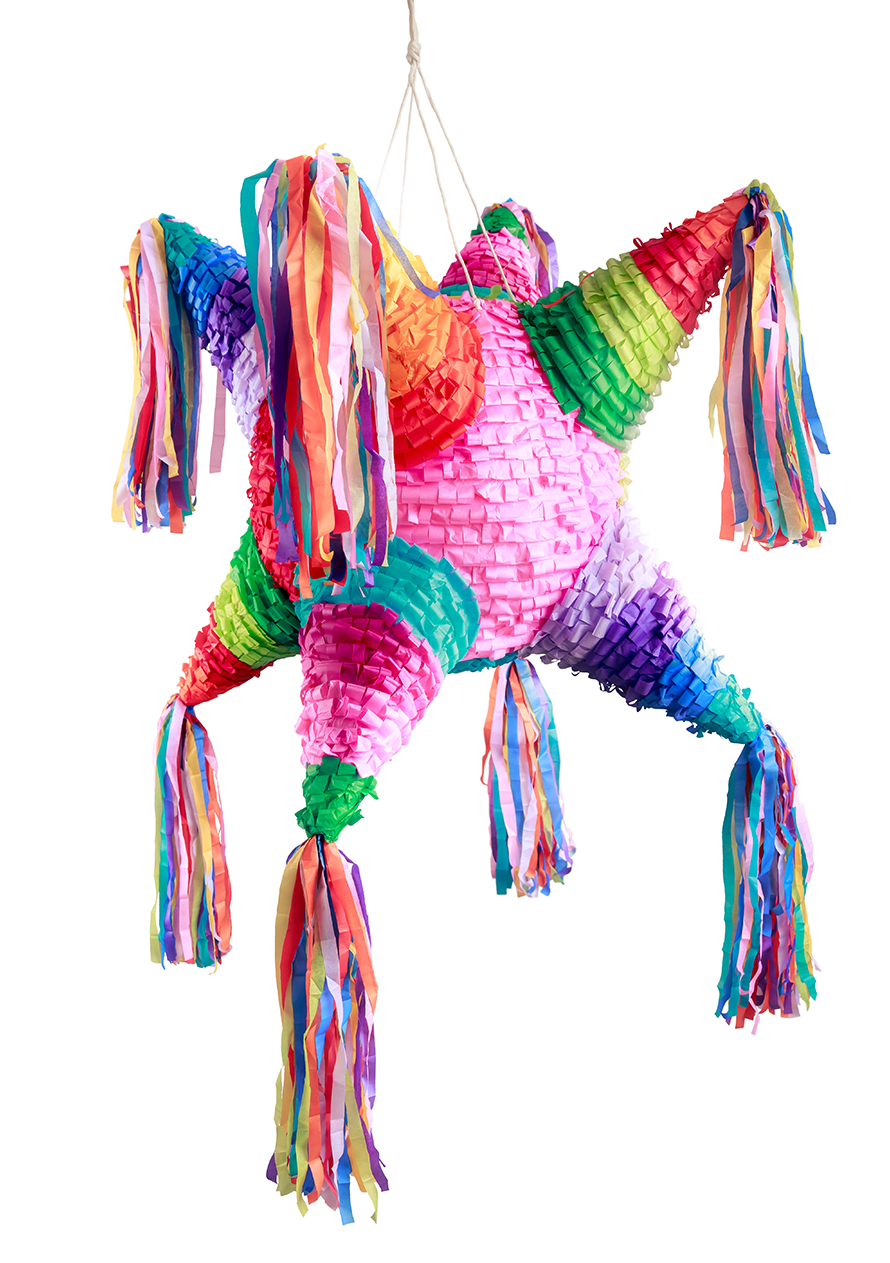
Pirekua is a traditional type of music among the P’urhépecha indigenous communities of the state of Michoacán. In 2015, it was inscribed in UNESCO’s Intangible Cultural Heritage List.
This genre arose from the syncretism of music and religious chants of Spanish evangelizers and pre-Hispanic songs and African influences, inheritted from the slaves who arrived to Mexico from those lands.
Pirekua means “song” in the P’urhépecha language and can be performed in a solo, duet, trio, choir and orchestra, by both men and women who are known as pirériechas. Traditionally it is sung in native language, but there are some pieces in Spanish and others are instrumental.
Pirériechas are very respected, since they are social mediators using songs to express sentiments and communicate events of importance to the communities. Songs and techniques are passed from generation to generation and constitute a pillar within their traditions.
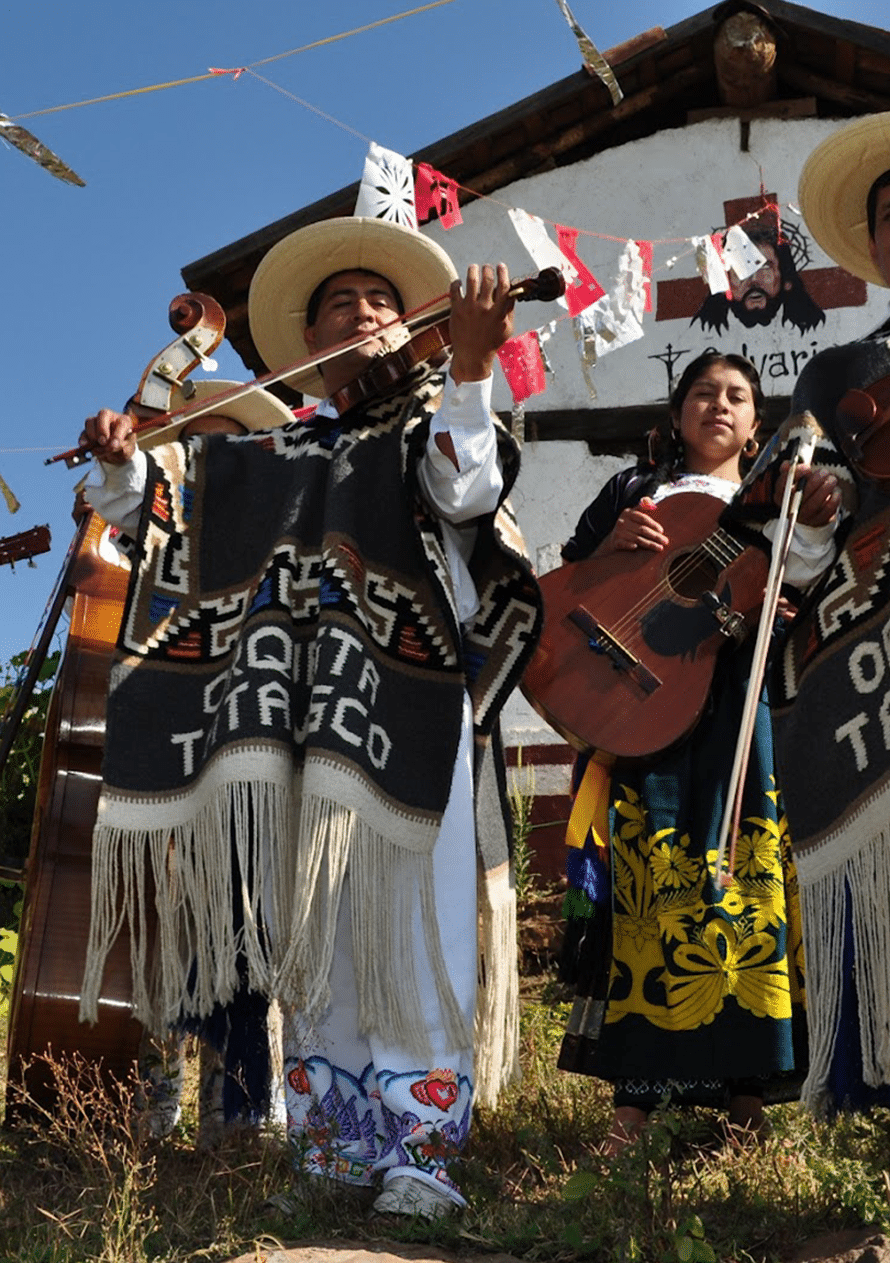
Sergio Pitol’s (Puebla, Puebla 1933–Jalapa, Veracruz 2018) literary calling is vitally attached to that of a traveler in transit. His wandering nature took him to many countries as a professor, translator and diplomat or simply as an adventurer in search of universes to narrate.
Every certain mileage he found an excuse to settle in places as different as Beijing or Warsaw, and turn to the knowledge of the local language or the work of a writer, which he later translated into Spanish.
His work as a translator has been fundamental for the knowledge of essential authors such as Henry James, Robert Graves, Anton Chekhov, Witold Gombrowicz or Vladimir Nabokov. The translation of hundreds of books from Polish, English, Italian and French is owed to Pitol.
The journey and interpretation —of languages, worlds, facts or characters—permeated his narrative work and can be appreciated in his stories and in his Trilogy of Memory, consisting of The Art of Flight (1996), The Journey (2000) and The Magician of Vienna (2005).
In 2005, his career was acknowledged with the Cervantes Prize and in 2006 the Instituto Cervantes’ library in Sofia, Bulgaria was inaugurated in his honor.

Manuel María Ponce (Fresnillo, Zacatecas, 1882–Mexico City, 1948) is an omnipresent name in Mexican musical history. A pioneer of the nationalist school, he left a legacy that includes one of the most extensive, and beautiful musical works. He innovated and influenced the music and composition scene of his time.
He wrote for voice, piano, guitar, violin and cello, as well as chamber and orchestral music.
One of his works that made him famous around the world was the song “Estrellita”, which acquired such celebrity that many believe it is a folk melody.In addition to composing, he was an excellent pianist and dedicated much of his life to teaching. He was director of the National School of Music and received the National Prize for Arts and Sciences in 1947.
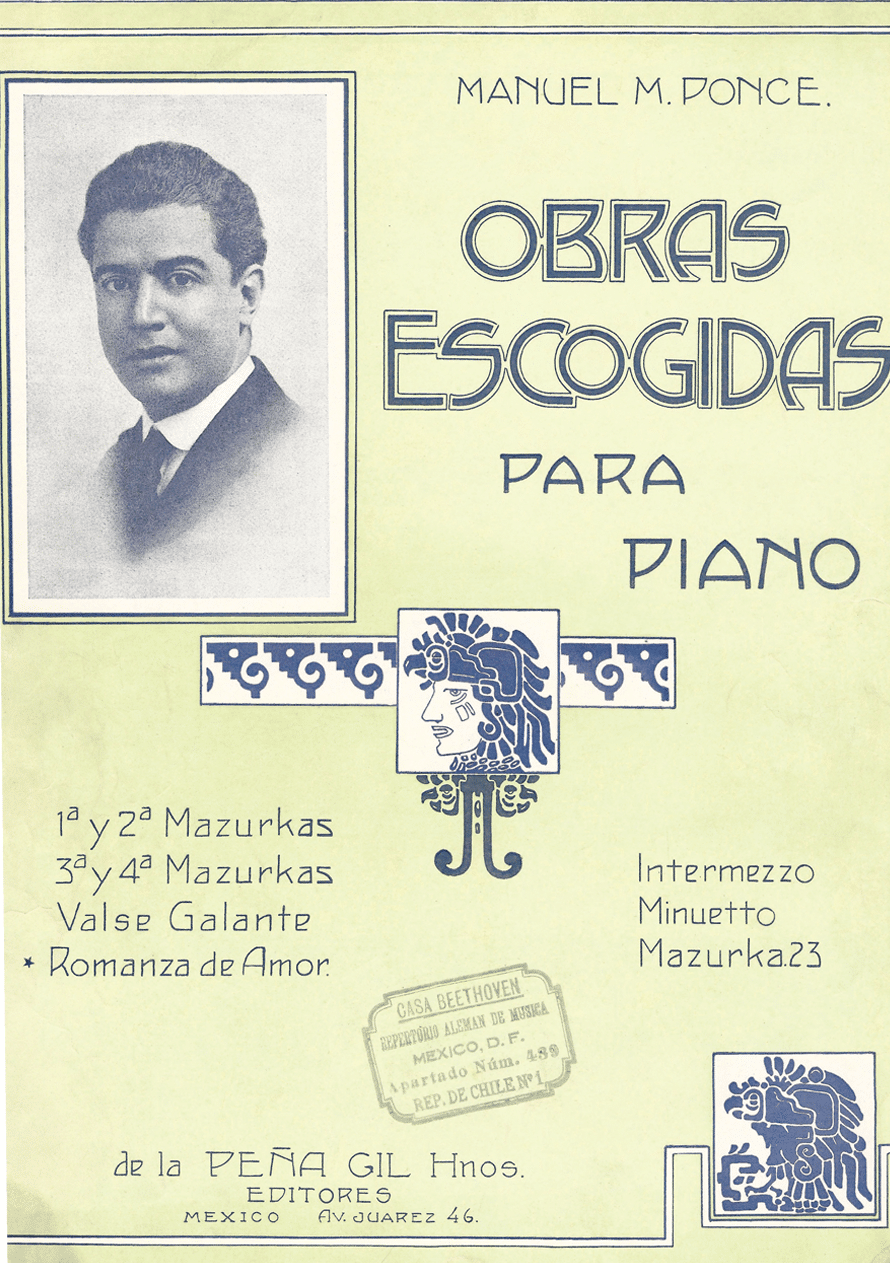
Elena Poniatowska (1932) was born in Paris, France. Her mother, Dolores Amor, born into a Porfirian family exiled in France after the Revolution, married the also exiled Prince Jean Poniatowski, heir to the Polish crown, so Elena was born with the title of Princess of Poland, which —she says— she cared very little about. When World War II broke out, the family returned to Mexico.
At age 18 and by then proven to be “more Mexican than mole”, with a mixture of curiosity and boldness, she began to interview great artists to research their creative process and the social sense of their work. Thus began her career as a journalist that is known for reflecting the feelings of ordinary people.
In 1968 newspaper Novedades refused to publish her report on the October 2nd massacre. That material, enriched, became the book Massacre in Mexico (1971), for which she was awarded the Xavier Villaurrutia Prize, an award she rejected because she considers that the date should be officially commemorated as national mourning.
She has combined her journalistic work with literature, delving in almost all genres: novel, short story, poetry, essay, chronicle, theater and texts for children. In her work, stories about women are notable, including: Tinísima (1991) —on the life of Italian photographer Tina Modotti—, Las soldaderas (1999) or Leonora (2014) —a portrait of Leonora Carrington.
In 2013, she was the first woman to receivethe Cervantes Prize.

Pozole is a broth prepared with cacahuazintle maize, meat and chili, garnished with chopped radish, onion and lettuce. It is the quintessential dish of national celebrations, although since its pre-Hispanic origin it has been linked to great festivities.
According to Friar Bernardino de Sahagún’s descrip-tion in General History of the Things of New Spain, during the rites in honor of god Xipe Tótec —the skinned lord, god of regeneration, maize and earth— Emperor Moctezuma was served a plate with the thigh of a sacrificed man, boiled with maize. This ritual dish was called tlacatlaolli and is the precursor of pozole, name derived from the Nahuatl pozolli, which means “boiled” or “frothy”.
Nowadays it is traditionally prepared with pork meat, although there are also states in the country where they prefer it with chicken and even with sardine or shrimp.
There is white pozole, which is accompanied by tomato or tomato-based sauces: green or red, depending on its ingredients. Both can be served with oregano and lime juice.

Like Rostropovich, Carlos Prieto is a true champion of the cello.39
Yo-Yo Ma
Carlos Prieto (Mexico City, 1937) has the spirit of a Renaissance man: he is an engineer and economist —graduated from MIT—, writer, researcher, diplomat, academic and one of the most respected cellists in the world.
He began playing the cello at age four, but his learning began earlier, in the womb, from where he heard the rehearsals of the string quartet his parents, his grandfather and his uncle had put together. He says that ever since then, his mother decided that he would be a cellist.
He is a tireless promoter of Mexican and Latin American composers. Thanks to his initiative, countless works have been written for cello, which he has presented in the most prestigious music halls in the world and with orchestras such as the London Royal Philharmonic, the American Symphony Orchestra in New York, the Berlin Symphony Orchestra, the Moscow Chamber Orchestra, the Spanish National Orchestra, among many others.
He is the only musician enrolled in the Mexican Academy of Language, acknowledged for his work as a researcher and author of more than ten books, among which are The Adventures of a Cello (2011) and Throughout China with the Cello (2009), with a foreword by Yo-Yo Ma. His works have been translated into English, Russian and Portuguese.
Preserving the centenary tradition of the family string quartet, he is a member of the third Prieto Quartet, along with his brother Juan Luis and his children, violinists Juan Luis Jr. and Carlos Miguel Prieto —who is also considered the leading Mexican conductor of his generation, appointed Conductor of the Year 2019 by Musical America.
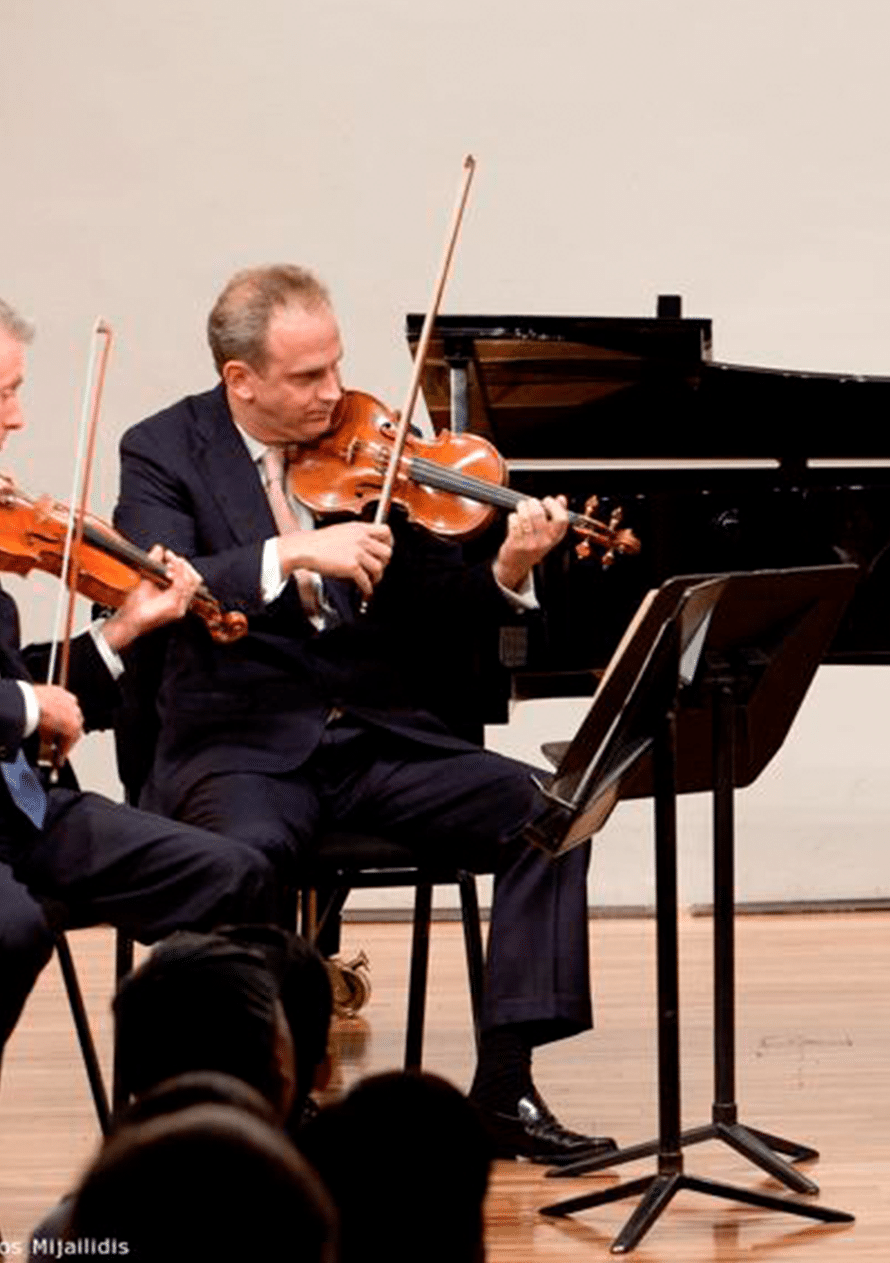
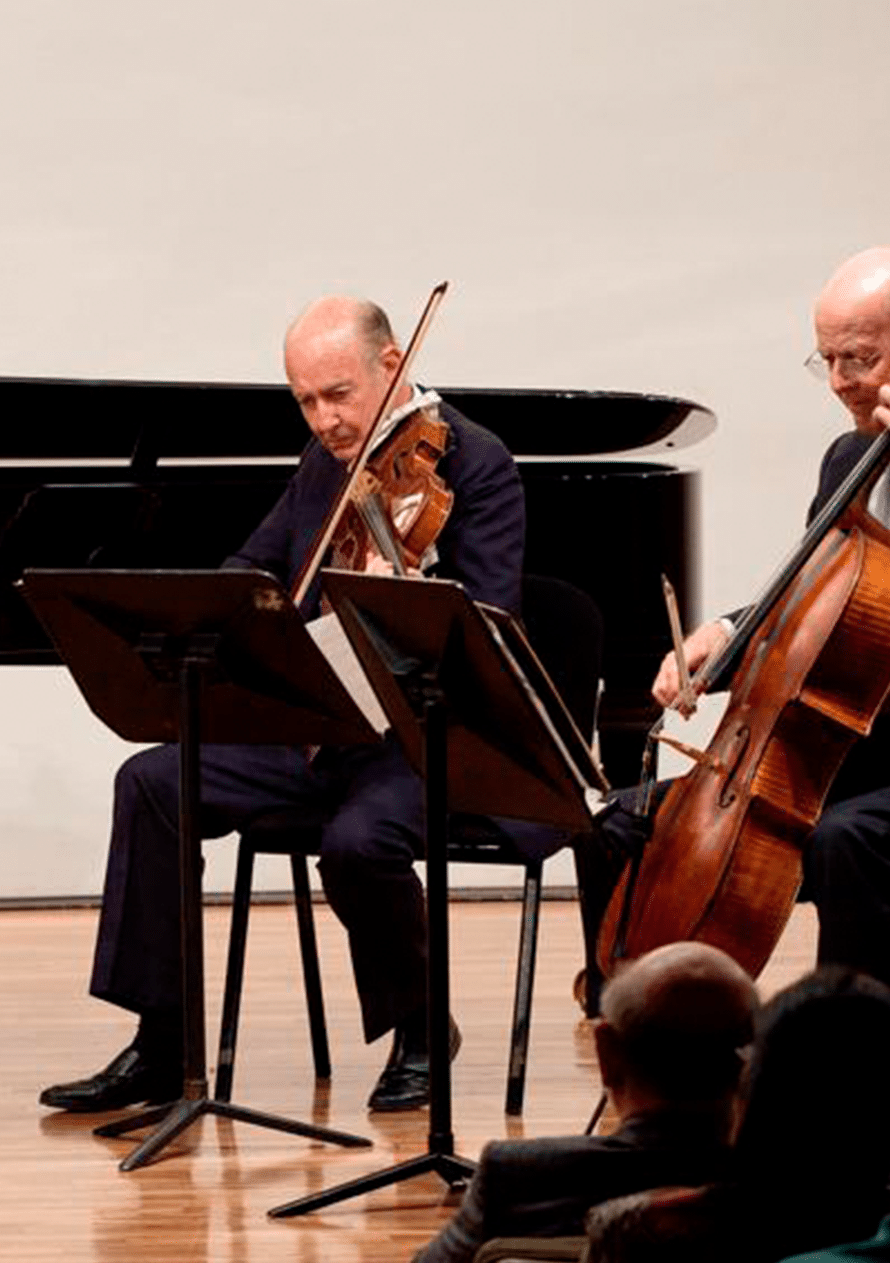
Rodrigo Prieto (Mexico City, 1965) is one of the most prominent Mexican cinematographers of his generation, whose work is defined by his constant innovation in technique and by the development of a versatile and discreet visual world.
His talent for transitioning between genres and styles has allowed him to decipher the vision of directors as different from each other as Francis Lawrence, Pedro Almodóvar, Curtis Hanson or Spike Lee.
He has taken part in more than thirty feature films, among which are Broken Embraces (2009) by Pedro Almodóvar, and The Wolf of Wall Street (2013) by Martin Scorsese. His achievement in cinematography earned him nominations for an Academy Award for Brokeback Mountain (2006) directed by Ang Lee, and for Silence (2017) by Martin Scorsese. He was also a BAFTA nominee for Babel (2006) by Alejandro González Iñárritu.
Rodrigo Prieto, Guillermo Navarro and Emmanuel Lubezki belong to a group of outstanding cinematographers who redefined Mexican cinema in the 1990s and who, over the years, have conso- lidated their careers within world cinema with unmatched styles.



